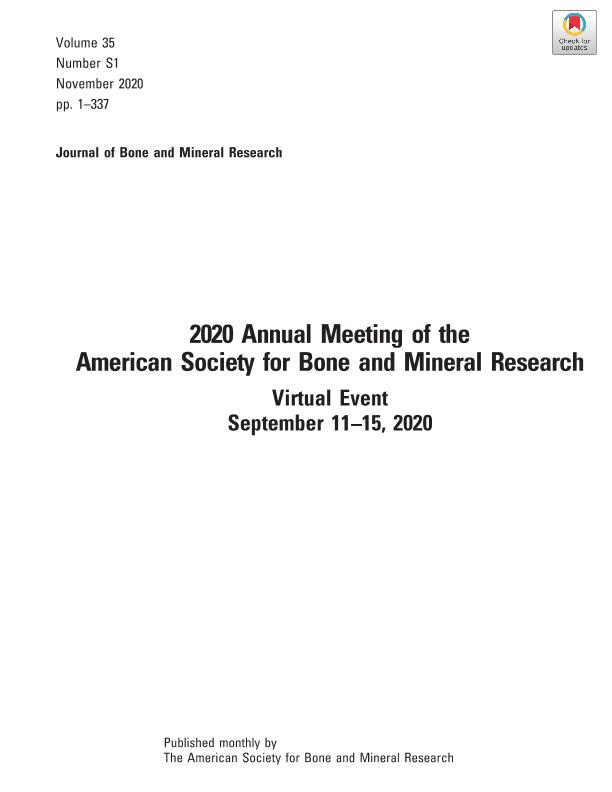Mostrar el registro sencillo del ítem
dc.contributor.author
Cutini, Pablo Hernan

dc.contributor.author
Campelo, Adrián Esteban

dc.contributor.author
Massheimer, Virginia Laura

dc.contributor.other
Civitelli, Roberto
dc.date.available
2022-10-24T12:35:26Z
dc.date.issued
2020
dc.identifier.citation
Progesterone (Pg) and Medroxyprogesterone acetate (MPA) regulate same events with opposite actions in bone and vascular cells; 2020 Annual Meeting of the American Society for Bone and Mineral Research; Estados Unidos; 2020; 1-5
dc.identifier.issn
0884-0431
dc.identifier.uri
http://hdl.handle.net/11336/174498
dc.description.abstract
Bone and cardiovascular diseases are multifactorial clinical entities that often coexist in postmenopausal women. Clinical and epidemiological studies have shown an interesting relationship between high bone turnover and cardiovascular disease mortality. Disorders in bone metabolism reversely correlate with vascular calcification (VCa). Hormone replacement therapy including natural Pg or synthetic progestins such as MPA emerged as a therapeutic option, although the risk/benefit of its use is controversial. VCa developed within atherosclerotic plaque is partly due to the osteogenic transdifferentiation of vascular smooth muscle cells (VSMC). The aim of this work was to investigate the effect of Pg and MPA on cellular/molecular events involved in VCa and in osteoblastogenesis. Primary cultures of calvarial osteoblasts (OB) and aortic VSMC, were in vitro exposed to 10 nM Pg or 10 nM MPA. Measurements of matrix extracellular calcium content and alkaline phosphatase (ALP) activity were employed as osteoblastic differentiation markers. In order to promote osteoblastic differentiation, VSMC were cultured for 21 days in osteogenic medium (10 mM β-glycerophosphate and 4 mM CaCl2). When VSMC were cultured in osteogenic medium (VSMC-OB), treatment with Pg for 21 days significantly reduced ALP activity (15% below control, p<0.02) and calcium content (32% below control, p<0.02). Similar treatment with the synthetic progestin also showed a significant reduction in ALP activity (239.9 ± 21.0 vs. 159.6 ± 19.1 x103 IU/mg protein, control vs MPA, p<0.02), as well as in the extracellular calcium deposition (365.1 ± 38.2 vs 253.6 ± 21.9 µg/mg protein, control vs MPA, p<0.02). Conversely, exposure of OB cells to Pg or MPA significantly increased ALP activity (59%; 290% above control, Pg; MPA, p<0.02) and matrix calcium levels (12%; 55% above control, Pg; MPA, p<0.02). The mechanism of action of Pg and MPA on both cells involves the participation of Pg receptor (PgR), since pre-treatment of cells with RU486, a PgR antagonist, completely reversed the hormonal action. However, we ruled out the involvement of the androgen receptor (AR), since in the presence of the AR antagonist flutamide, the effect of the progestogens was sustained. In conclusion, although Pg and MPA exert opposite effects on OB and VSMC-OB, both steroids would exhibit a potential beneficial effect by promoting osteoblastic differentiation and inhibiting VCa.
dc.format
text/plain
dc.language.iso
eng
dc.publisher
Wiley

dc.rights
info:eu-repo/semantics/openAccess
dc.rights.uri
https://creativecommons.org/licenses/by-nc-sa/2.5/ar/
dc.subject
VASCULAR CALCIFICATION
dc.subject
VASCULAR SMOOTH MUSCLE CELLS
dc.subject
OSTEOBLASTS
dc.subject
PROGESTINS
dc.subject.classification
Bioquímica y Biología Molecular

dc.subject.classification
Ciencias Biológicas

dc.subject.classification
CIENCIAS NATURALES Y EXACTAS

dc.title
Progesterone (Pg) and Medroxyprogesterone acetate (MPA) regulate same events with opposite actions in bone and vascular cells
dc.type
info:eu-repo/semantics/publishedVersion
dc.type
info:eu-repo/semantics/conferenceObject
dc.type
info:ar-repo/semantics/documento de conferencia
dc.date.updated
2022-03-16T21:02:07Z
dc.journal.volume
35
dc.journal.number
1
dc.journal.pagination
1-5
dc.journal.pais
Países Bajos

dc.journal.ciudad
Amsterdam
dc.description.fil
Fil: Cutini, Pablo Hernan. Consejo Nacional de Investigaciones Científicas y Técnicas. Centro Científico Tecnológico Conicet - Bahía Blanca. Instituto de Ciencias Biológicas y Biomédicas del Sur. Universidad Nacional del Sur. Departamento de Biología, Bioquímica y Farmacia. Instituto de Ciencias Biológicas y Biomédicas del Sur; Argentina
dc.description.fil
Fil: Campelo, Adrián Esteban. Consejo Nacional de Investigaciones Científicas y Técnicas. Centro Científico Tecnológico Conicet - Bahía Blanca. Instituto de Ciencias Biológicas y Biomédicas del Sur. Universidad Nacional del Sur. Departamento de Biología, Bioquímica y Farmacia. Instituto de Ciencias Biológicas y Biomédicas del Sur; Argentina
dc.description.fil
Fil: Massheimer, Virginia Laura. Consejo Nacional de Investigaciones Científicas y Técnicas. Centro Científico Tecnológico Conicet - Bahía Blanca. Instituto de Ciencias Biológicas y Biomédicas del Sur. Universidad Nacional del Sur. Departamento de Biología, Bioquímica y Farmacia. Instituto de Ciencias Biológicas y Biomédicas del Sur; Argentina
dc.relation.alternativeid
info:eu-repo/semantics/altIdentifier/doi/https://doi.org/10.1002/jbmr.4206
dc.relation.alternativeid
info:eu-repo/semantics/altIdentifier/url/https://asbmr.onlinelibrary.wiley.com/doi/10.1002/jbmr.4206
dc.conicet.rol
Autor

dc.conicet.rol
Autor

dc.conicet.rol
Autor

dc.coverage
Internacional
dc.type.subtype
Reunión
dc.description.nombreEvento
2020 Annual Meeting of the American Society for Bone and Mineral Research
dc.date.evento
2020-09-11
dc.description.paisEvento
Estados Unidos

dc.type.publicacion
Journal
dc.description.institucionOrganizadora
American Society for Bone and Mineral Research
dc.source.revista
Journal of Bone and Mineral Research

dc.date.eventoHasta
2020-09-15
dc.type
Reunión
Archivos asociados
